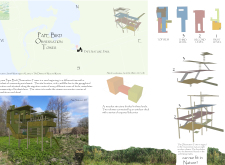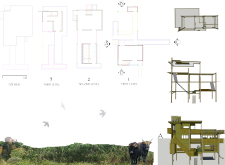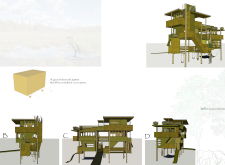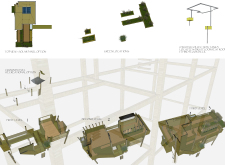5 key facts about this project
Upon first glance, the project exhibits a contemporary design vocabulary characterized by clean lines and a thoughtful arrangement of volumes. The façade, constructed from a combination of concrete, glass, and metal, showcases a modern aesthetic while ensuring durability and low maintenance. The use of expansive glass panels allows natural light to flood the interior spaces, fostering an inviting atmosphere that encourages interaction and collaboration. This design approach not only serves to highlight the interior architecture but also aligns with principles of sustainability by reducing the need for artificial lighting during daylight hours.
Internally, the layout is meticulously engineered to optimize functionality and flow. Spaces are thoughtfully arranged to accommodate a variety of uses, from communal gathering areas to private workspaces. The choice of materials extends to the interior, where warm wood finishes complement the industrial concrete and glass, creating a balanced and welcoming environment. This careful selection of materials reflects an understanding of human-centric design, emphasizing comfort and usability.
Unique design elements, such as green roofs and integrated landscaping, demonstrate a commitment to environmental stewardship and enhance the overall aesthetic appeal of the project. These features contribute to biodiversity while providing users with accessible areas for relaxation and recreation. The integration of biophilic design principles encourages occupants to engage with nature, promoting well-being and enhancing productivity within the space.
A significant aspect of this project is its responsiveness to the surrounding environment and community needs. The architectural design incorporates local materials and innovative construction techniques tailored to the climate and culture of the region. This approach not only supports the local economy but also aligns the project with sustainable practices, reducing its carbon footprint.
The architectural plans reveal not only the spatial organization but also the meticulous attention to detail that defines the project. Architectural sections illustrate the interplay between different materials and structural systems, highlighting how light, ventilation, and spatial dynamics are masterfully orchestrated. The thoughtful incorporation of outdoor spaces, such as terraces and courtyards, encourages outdoor activities and community engagement.
Moreover, the project offers insights into contemporary architectural ideas by embracing flexibility in the design. Spaces can easily be reconfigured to suit evolving needs, ensuring that the facility remains relevant and functional over time. This adaptability is a key consideration in modern architectural practices, allowing the building to not only serve current use but also adapt to future requirements.
As an architectural endeavor, this project stands as a testament to the possibilities inherent in thoughtful design. Its success lies in its ability to resonate with users, providing them with an environment that is both functional and reflective of their values and needs. It invites viewers and stakeholders alike to engage with its architectural narrative, encouraging exploration of various components, including detailed architectural plans, sections, and designs.
For those interested in an in-depth understanding of this project and its implications within the broader field of architecture, we encourage you to delve deeper into the architectural presentation, exploring its elements and the innovative design approaches that set it apart.


























